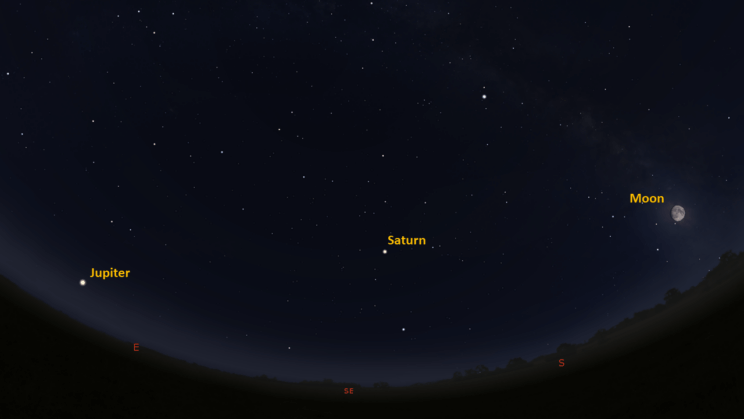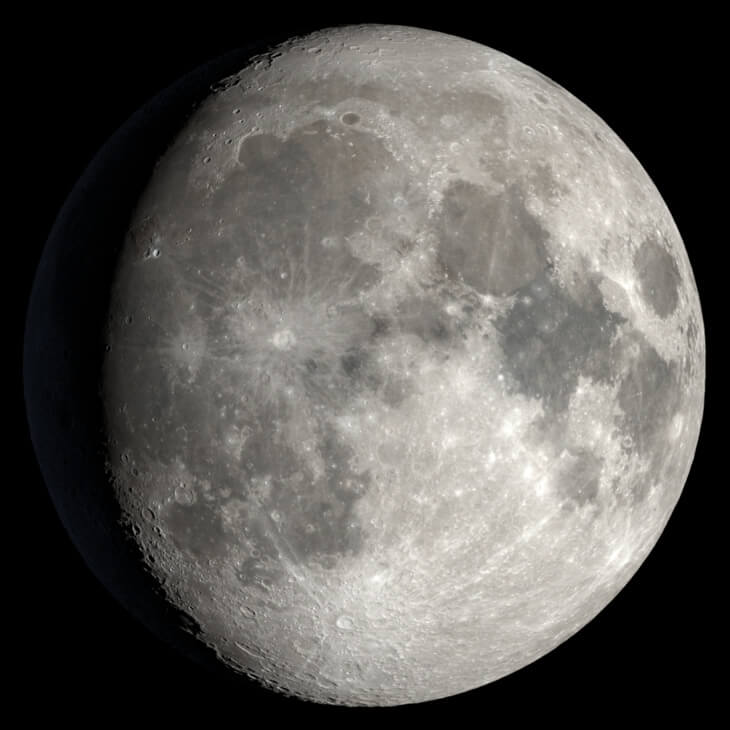This is the Saint Louis Science Center’s NIGHT SKY UPDATE for the week of Saturday, July 29, 2023.
Information updated weekly or as needed.
Times given as local St. Louis time which is Central Daylight Time (CDT). For definitions of terminology used in the night sky update, click the highlighted text. If relying on times posted in Universal Time (UT), St. louis is -5 hours when CDT.
Public Telescope Viewings
As part of the Saint Louis Science Center’s First Fridays, weather permitting, the St. Louis Astronomical Society and the Science Center will set up a number of telescopes outdoors and be on-hand to answer your questions. Telescope viewing begins once it is dark. Regardless of the weather on August 4 , join us indoors in our planetarium theater for “The Sky Tonight”. Showtime is at 7 p.m. There is no First Friday event in July.
Observing Highlight of the Week
The Moon seen on July 29, 2023. Image credit: NASA’s Scientific Visualization Studio, Ernie Wright, Noah Petro, David Ladd
Throughout August this year, the Moon will be an interesting topic for exploration. As always, the Moon will pass by each of the visible planets, there are two full moons this month, the Moon will occult the bright star Antares, and finally, the Moon will not be an interference for this year’s peak of the Perseids.
The Moon is one of the most interesting objects in the sky. In ancient times, its predictable behavior became our basis for time. These same predictable motions allowed the Babylonians to predict the occurrence of lunar and solar eclipses. Watching the Moon each night is a long past-time for our species that any of us can still do today regardless of what astronomical instruments you have.
Each day, the Moon will move about 13° amongst the background stars. This occurs because the Moon is orbiting the Earth which is the cause of lunar phases. Depending on where the Moon is in its orbit, we will see a different percentage of the lunar disk illuminated each night. This cycle of the Moon takes approximately 29.5 days to occur which is called a synodic month. This week, we will see the Moon exhibit waxing gibbous, full, and waning gibbous phases. On July 29, 2023, the Moon will exhibit a waxing gibbous phase with 89% disk illumination. By August 6, 2023, it will be a waning gibbous phase with 65% disk illumination.
The Moon reaches its first full phase this calendar month on August 1, 2023. Since our calendars are no longer lunar based, an average calendar month is slightly longer than the synodic month. Due to this, it is possible to have a second full moon in a calendar month. The Moon will again reach its full phase on August 30, 2023. When two full moons occur in a month, it is described as a blue moon.
Blue moons come in two varieties. The one that occurs in August this year is called a monthly blue moon. This is defined as when two full moons occur in a calendar month. The other type of blue moon is called a seasonal blue moon. This occurs when one season has four instead of three full moons. Each type of blue moon occurs every 2 to 3 years and the next seasonal blue moon is in August of 2024.
Both full moons in August 2023 occur when the Moon is near perigee. This is when the Moon is nearest to Earth which can have a large impact on the magnitude of high and low tides. When full or new moon occurs near perigee, it is called a perigean spring tide. In some coastal areas high tides can vary as much as three feet.
In August, the visible planets are Mars, Saturn, Neptune, Jupiter and Uranus. They are listed in order of rise times. For those learning to spot the planets, the Moon can be a helpful guide each month. The Moon will pass by each planet as it completes its synodic cycle. The Moon is near Saturn on the 3rd, Neptune on the 4th, Jupiter on the 8th, Uranus on the 9th and Mars on the 18th.
Also in August, most of North America will witness a lunar occultation. On August 24, 2023, the Moon will occult the bright star Antares. The occultation begins at 9:28 p.m. CDT and ends at 10:33 p.m. CDT. The entirety of the occultation is visible from St. Louis, but the end will be difficult to see as the Moon and Antares will only be 10.4° above the horizon.
Lastly, new moon occurs on August 16, 2023. This is important because the Perseid meteor shower peaks in the early morning of August 13, 2023. On the night of the Perseid peak, the Moon will exhibit a waning crescent phase that is only 9% illuminated. The closer to new moon, the darker the sky will be. From a dark location, the Perseids have a ZHR of 100 meteors per hour. This is a meteor shower that is worth driving somewhere dark to see. We will cover the Perseids in greater detail as we approach the peak date in August.
The Sun and Moon

The Moon as seen from the International Space Station, on July 31, 2011.
Credit: NASA
Sun
Sunrise is at 6:00 a.m. on Friday, July 29 and sunset is at 8:14 p.m. providing us with roughly 14 hours of daylight. Even after sunset, light from the Sun will dimly illuminate our sky for about 1 hour and 45 minutes. This period is called twilight, which ends around 10:01 p.m. this week. For those with a sundial, local noon occurs around 1:07 p.m. this week.
| Day | Sunrise | Sunset | ||||||||||
|---|---|---|---|---|---|---|---|---|---|---|---|---|
| 29-Jul | 6:00 a.m. | 8:14 p.m. | ||||||||||
| 30-Jul | 6:00 a.m. | 8:13 p.m. | ||||||||||
| 31-Jul | 6:01 a.m. | 8:12 p.m. | ||||||||||
| 1-Aug | 6:02 a.m. | 8:11 p.m. | ||||||||||
| 2-Aug | 6:03 a.m. | 8:10 p.m. | ||||||||||
| 3-Aug | 6:04 a.m. | 8:09 p.m. | ||||||||||
| 4-Aug | 6:05 a.m. | 8:08 p.m. | ||||||||||
| 5-Aug | 6:06 a.m. | 8:07 p.m. | ||||||||||
| 6-Aug | 6:07 a.m. | 8:06 p.m. |
Moon
Moonrise for Saturday, July 29 was at 5:59 p.m. and moonset occurs at 3:01 a.m. on the following day. On Saturday, July 29, the Moon will exhibit a waxing gibbous phase with 89% disk illumination. Full moon occurs on August 1, 2023, at 1:32 p.m. This is the first of two full moons in August.
International Space Station (ISS) Observing

There are several visible passes of ISS from St. Louis for the week of July 29. They occur during evening hours. The best passes for this week are listed below. Use the table below for information about these passes.
Catch ISS from St. Louis starting Saturday, July 29
| Date | Starts | Max. altitude | Ends | |||||||
|---|---|---|---|---|---|---|---|---|---|---|
| Time | Alt. | Az. | Time | Alt. | Az. | Time | Alt. | Az. | ||
| 30 Jul | -3.2 | 21:36:58 | 10 | WNW | 21:40:12 | 48 | SW | 21:41:30 | 29 | SSE |
| 31 Jul | -3.8 | 20:48:34 | 10 | NW | 20:51:56 | 90 | SE | 20:55:08 | 11 | SE |
Magnitude (Mag): The Measure of brightness for a celestial object. The lower the value is, the brighter the object will be.
Altitude (Alt): The angle of a celestial object measured upwards from the observer’s horizon.
Azimuth (Az): The direction of a celestial object, measured clockwise from an observer’s location with north being 0°, east being 90°, south being 180° and west being 270°.
For information about ISS flyovers and other visible satellites, visit www.heavens-above.com
Detailed information regarding all unmanned exploration of our universe, missions past, present, and planned, can be found at Jet Propulsion Laboratories:
The Visible Planets

Looking Southeast at 1:00 a.m. on July 30, 2023. Credit: Stellarium, EG
This week, two/four naked eye planets will be visible. Venus and Mars will likely be too low for most to see. They are found low in the west after sunset. Both planets will be 10° or lower once visible. Saturn and Jupiter will be easy to find but you will have to go out in the late evening and morning hours. Saturn will be in the southeast around midnight while Jupiter will be east in the early morning.
Venus
The window to observe Venus is closing. Venus now sets around 8:47 p.m. Venus reaches inferior conjunction on August 13, 2023. Evening views of the planet will end as we reach August 1, 2023. For most, our window to observe Venus has closed. If you have a clear view of the west, you might still catch a view of Venus but make sure the Sun has set before you try.
Mars
Mars now rises before sunset, becoming visible once it is dark. Look for it in the west about 30 minutes after sunset. Mars sets at 9:51 p.m.
Jupiter
Jupiter rises at 12:27 a.m. About one hour after Jupiter rises, it should be easy to spot. Jupiter will rise about 20 minutes earlier each week.
Saturn
Saturn rises at 9:39 p.m. Start looking for Saturn about 30 minutes after it rises. If you have lots of trees or buildings, you may have to wait an hour or so after it rises before it will be visible.
James S. McDonnell Planetarium
Night Sky Update: July 29-August 6, 2023







